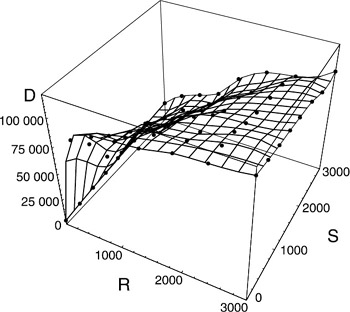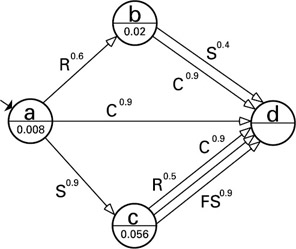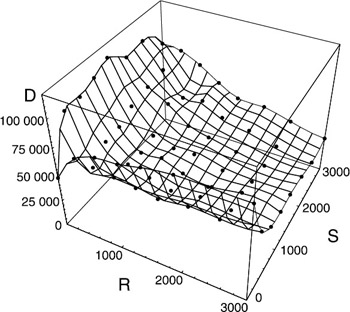1.8 Multienzyme Response Surfaces: A Simulated Example
|
1.8 Multienzyme Response Surfaces: A Simulated Example
The XOR demonstration points to the possibility of using networks of enzymes to create computationally richer response surfaces. This would only be of interest if the response of the individual components of the network interact in a nonlinear fashion. Placing multiple enzyme species in a common milieu can then lead to a response surface that is quite different from the summation of the surfaces yielded by the enzymes taken in isolation.
We have developed a software simulation tool to investigate the interaction of conformational, kinetic (reaction-diffusion), structural, and dynamic (force) interactions of protein networks in three-dimensional space that for the present purposes can be used to illustrate this nonadditivity (Zauner 1996; Zauner and Conrad 1997).
Materials
UV-spectrophotometer (ƛ = 339 nm); analytic scale; adjustable micropipettes (200 μl, 1 ml); pH meter; timer.
Malate dehydrogenase from porcine heart, as ammonium sulfate suspension (store refrigerated); NAD+ (oxidized β-nicotinamide adenine dinucleotide), as free acid (store refrigerated or frozen); l-malic acid, as free acid; MgCl2 as magnesium chloride hexahydrate (MgCl2 6H2O); MOPS (3-[N-morpholino]propanesulfonic acid); glycine (aminoacetic acid), as free acid; 10 N HCl and 10 N NaOH (for pH adjustment); pure (distilled) H2O. (Below, "water" always refers to pure H2O.)
Method
-
Basis Solution for signals (120 mM glycine, 7.5 mM l-malic acid, 1 l): Dissolve 9 g glycine in about 950 ml water. Add 1 g l-malic acid and allow to dissolve while stirring. Adjust to pH 10.5 with 10 N NaOH. Fill with water to a final volume of 1000 ml.
-
MgCl2 Solution (4 M MgCl2, 50 ml): Dissolve 40.66 g MgCl2 6H2O in 15 ml hot water. Let the solution cool to room temperature. Fill with water to 50 ml.
-
Signal solutions: Add 5 ml of water to 100 ml of the signal basis solution (1). The resulting solution is used for 0-signals. Add 5 ml of the MgCl2 solution (2) to 100 ml of the signal basis solution (1). The resulting solution is used for 1-signals.
-
Enzyme solution (MDH/NAD+, 10 ml): Dissolve 20.93 g MOPS in about 300 ml water, then fill up to 475 ml. Adjust pH to 7.4 with 10 N NaOH. Fill up with water to a final volume of 500 ml. This is the 0.2 M MOPS buffer. Weigh 36 mg of NAD+ into a test tube that can hold 10 ml fluid and is wide enough to access with the 1 ml micropipette. Add 10 ml of the 0.2 M MOPS buffer and shake to dissolve the NAD+. Add about 20 μl malate dehydrogenase suspension and shake. If the response time for the signal processing is found to be too slow, more of the enzyme suspension can be added to the solution.
-
The volume of the signal solutions and the reaction solution may need to be adjusted for the particular spectrophotometer used. The minimum volume required to cover the beam path can be determined by marking the beam at ƛ ≅ 540 nm on a white piece of paper fixed to the cuvette. If this volume is larger than 2.1 ml, the volume for the signals and the enzyme solution (6 and 8) should be adjusted proportionally.
-
The input signal pattern is composed of two 0.8 ml portions taken in any combination from the two signal solutions (3). The signal solutions are pipetted into a cuvette.
-
Set the spectrophotometer to continuously record absorbance at ƛ = 339 nm.
-
To start the processing, pipette 0.5 ml of the enzyme solution (4) into the cuvette containing the signal solutions (6). A timer is started and the cuvette content is mixed (e.g., by inverting the sealed cuvette or by stirring when the enzyme solution is added).
-
Record the progress of the reaction for various combinations of the input signals by repeating steps 6 through 8. Choose a response time that will separate 00 and 11 input patterns from 01 and 10 inputs and determine the threshold level from the corresponding absorbance values.
-
Signals can now be processed using the time and threshold determined in the calibration step (9).
| Note | The above protocol can serve as a starting point to explore other signaling substances. It is quite robust and could easily be adapted (e.g., replacing the micropipettes with disposable syringes) for classroom use. |
The basic concept of the simulator is as follows. The simulation space, a threedimensional lattice, contains two classes of components: macrocomponents and microcomponents. The former represent proteins, and the latter represent milieu substances—that is, metabolites on which the proteins act catalytically, as well as control molecules and ions that trigger conformational changes. The microcomponents are represented by the integer number present in each unit cell. Each catalytic or diffusional event is associated with an integer increment or decrement of this number.
The macrocomponents are represented in the simulation space by dodecahedra, each consisting of up to twelve coupled finite-state automata that model active protein domains. Recognition, binding, control, and catalytic properties are assigned to the states of these domains. The state transitions of the domains correspond to conformational changes. Transition probabilities depend on the local milieu, and therefore on the microcomponents present in the location of the dodecahedra and on adjacent macrocomponents. The local milieu can change through reaction (catalyzed by macrocomponents) and by diffusion. The whole system forms a loop encompassing context, conformation, and action. Milieu molecules and adjacent macrocomponents provide the context in which enzymes function. This influences conformation. Conformation controls action, including catalysis and structure formation. Catalysis and structure formation in turn control context, and so on (figure 1.7).

Figure 1.7: Schematic of interactions supported by the CKSD simulator (for simplicity limited to a three enzyme system). The enzymes (labeled by e1, e2, and e3) have from one to three states (labeled by the qi). States represent conformations. Arrows connecting states represent conformational transitions. These are typically influenced by the milieu components (dashed arrows) and also may be influenced by direct interactions between two enzymes (dashed arrow from e2 to e1). Specific conformational states catalyze milieu reactions (indicated by bent arrows). Enzymes in complementary conformational states may self-assemble to form quaternary structures (indicated by the double arrow between e1 and e2). Note that the transitions of distant enzymes may be coupled through their catalytic effect on the milieu.
For illustrative purposes, we consider two toy reactions running separately and then consider the response of the combined reaction. The first reaction, catalyzed by enzyme e1, is
![]()
We assume that e1 has ten conformational states that differ in the catalytic activity that they confer. The transition probabilities and activity associated with the different states are illustrated in figure 1.8. R and S in the figure denote substances used as milieu signals. The product D is chosen as output signal. The response surface of e1 with respect to R and S, illustrated in figure 1.9, shows that even a relatively small number of conformational states can yield a nontrivial surface.

Figure 1.8: Conformational transition used to simulate enzyme e1. The diagram is not based on any actual enzyme. The numbers below the state name indicate the relative catalytic activity of the state. Capital letters on the transitions refer to metabolites and signal molecules. The transition probabilities in the presence of these molecules is specified by superscripts.

Figure 1.9: Simulated response surface for enzyme e1 with respect to signaling substances R and S. The product D is used as the output value. The values in the diagram show the actual number of molecules present in the simulation space. The latter contained 200 e1 enzymes distributed on a 61 61 21 lattice.
For the second reaction, catalyzed by enzyme e2, we take
![]()
Here we assume that e2 has only four conformational states. As shown in the state transition diagram (figure 1.10), the enzyme is sensitive to the same two signaling substances, R and S, as e1. The response surface is shown in figure 1.11.

Figure 1.10: Conformational transition diagram for enzyme e2. See caption of figure 1.8 for explanation.

Figure 1.11: Simulated response surface for enzyme e2. The space contained 300 e2 enzymes; cf. figure 1.9.
Now suppose that both enzymes are introduced into the reactor. As can be seen from the reaction schemes above, e1 and e2 will then compete for substrate A and both will contribute to the output signal D. Furthermore, they affect each other's conformational transitions via the products C, D, and F (see figures 1.8 and 1.10). The resulting response surface is shown in figure 1.12. The response obtained by combining the enzymes cannot be easily predicted from knowledge of the response of the individual enzymes. This nonadditivity precludes the possibility of using a simpler user manual to anticipate the effect of adding components on the input-output map of the system. From our point of view, this means that it should be possible to build up molecular signal-processing modules that can implement transforms that cannot be achieved by linking the processing components in a context-independent way. The joint system self-organizes into a de novo transform.

Figure 1.12: Combined response surface resulting from interaction between enzymes e1 and e2.
|